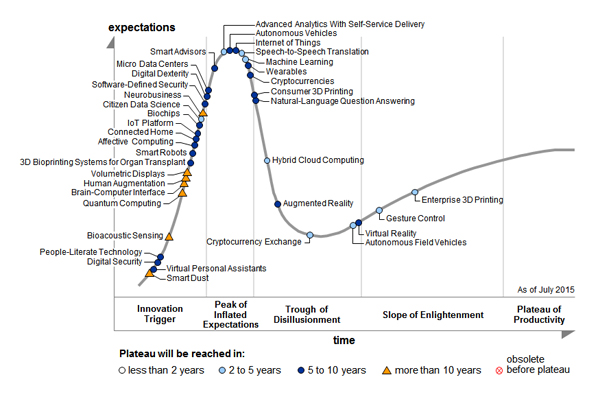Tech-hype: what’s up, down, and trending
Digital business emerges as leading force
- |
- Written by John Ginovsky

Technology and hype just go together, it seems. It’s always fun this time of the year to examine Gartner Inc.’s “Hype Cycle for Emerging Technologies,” an annual look at what’s up, what’s down, and what may actually gain long-term traction.
It needs to be said at the outset that Gartner has a penchant for coining its own terms—so much so that those terms sometimes need translation. Still, with patience, the firm’s observations prove interesting.
For example, study the intriguing graphic treatment that progresses from “innovation trigger” through “peak of inflated expectations”; “trough of disillusionment”; “slope of enlightenment”; and “plateau of productivity.”

While much of this doesn’t relate directly to banking, much does—and it provides a fascinating peek into the high-tech world to come.
Journey to digital
This year Gartner sees “the journey to digital business” as the key theme.
Gartner defines this as a focus on the convergence of people, business, and things. The Internet of Things and the concept of blurring the physical and virtual worlds are strong concepts in this stage. Physical assets become digitalized and become equal actors in the business value chain alongside already-digital entities, such as systems and apps.
New to the Hype Cycle this year is the emergence of technologies that support what Gartner defines as “digital humanism”—the notion that people are the central focus in the manifestation of digital businesses and digital workplaces.
Gartner’s Hype Cycle features “technologies that are the focus of attention because of particularly high levels of interest, and those that Gartner believes have the potential for significant impact," according to Betsy Burton, vice-president and distinguished analyst at Gartner.
"This year, we encourage CIOs and other IT leaders to dedicate time and energy focused on innovation, rather than just incremental business advancement, while also gaining inspiration by scanning beyond the bounds of their industry," adds Burton. "As enterprises continue the journey to becoming digital businesses; identifying and employing the right technologies at the right time will be critical."
Considering the “Nexus of Forces”
Getting down to specifics, Gartner spotlights digital marketing. Here it sees the emergence of what it calls the Nexus of Forces (mobile, social, cloud, and information).
Enterprises in this stage focus on new and more sophisticated ways to reach consumers, who are more willing to participate in marketing efforts to gain greater social connection, or product and service value.
Companies seeking to reach this stage should consider the following technologies on the Hype Cycle, according to Gartner: gesture control; hybrid cloud computing; internet of things; machine learning; and people-literate technology;
Going beyond the Nexus
Organizations seeking to go past the Nexus of Forces technologies to become a digital business should look to these additional technologies:
3D bioprinting for life science R&D; 3D bioprinting systems for organ transplant; human augmentation; affective computing; augmented reality; bioacoustics sensing; biochips; brain-computer interface; citizen data science; connected home; cryptocurrencies; cryptocurrency exchange; digital dexterity; digital security; enterprise 3D printing; smart robots; smart advisors; gesture control; internet of things; internet of things platform; machine learning; microdata centers; natural-language question answering; neurobusiness; people-literate technology; quantum computing; software-defined security; speech-to-speech translation; virtual reality; volumetric and holographic displays; and wearables.
The final frontier (for now)
“Autonomous” represents the final post-nexus stage. This stage is defined by an enterprise's ability to leverage technologies that provide humanlike or human-replacing capabilities.
Using autonomous vehicles to move people or products and using cognitive systems to recommend a potential structure for an answer to an email; write texts; or answer customer questions are all examples that mark the autonomous stage.
Enterprises seeking to reach this stage to gain competitive ability should consider these technologies on the Hype Cycle: autonomous vehicles; bioacoustic sensing; biochips; brain-computer interface; digital dexterity; human augmentation; machine learning; neurobusiness; people-literate technology; quantum computing; smart advisors; smart robots; virtual personal assistants; virtual reality; and volumetric and holographic displays.
Add one more tool: “smart dust.” This, according to Computerworld, refers to tiny, wireless microelectomechanical sensors that can detect anything from light to vibrations.
"Although we have categorized each of the technologies on the Hype Cycle into one of the digital business stages; enterprises should not limit themselves to these technology groupings," says Burton. "Many early adopters have embraced quite advanced technologies—for example; autonomous vehicles or smart advisors—while they continue to improve nexus-related areas, such as mobile apps."
Tagged under Lines of Business, Technology, Feature, Feature3,














